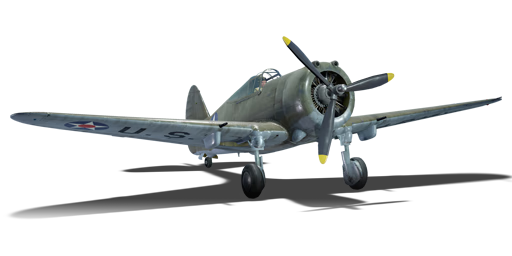



The P-36C is a American fighter. It was introduced in Update 1.31.
In the early 1930s, the Curtiss-Wright Corporation began a private venture to build a fighter aircraft which was a revolutionary departure from earlier cloth-covered biplanes of World War I. This project aircraft under development was named the Curtiss Hawk Model 75 (later it would be known by P-36 Hawk, Hawk-75 – or just H-75 and Mohawk). The P-36 was an all-metal monoplane (although the control surfaces were fabric-covered) with a 900 hp radial engine, enclosed cockpit and retractable landing gear. Even though this aircraft touted some of the state-of-the-art development in aircraft design, several aspects remained lacking, such as the original two machine guns firing through the propeller arc, a 7.62 mm and 12.7 mm and other critical components such as the absence of armour in the cockpit and self-sealing fuel tanks.
By May 1935 the first prototype flew and attained speeds of 281 mph (452 km/h) and reaching an altitude of 10,000 ft (3,000 m). It wasn't long before the original 900 hp Write XR-1670-5 radial engine was replaced with an upgrade Wright XR-1820-39 Cyclone at 950 hp and several modifications to the body of the aircraft was completed like the addition of scalloped rear windows which significantly improved the pilots rear view (although the hump on the back of the aircraft still blocked a significant portion of the view). This version of the aircraft was designated as Model 75B while oddly enough the earlier version with the 1670-5 was listed as a Model 75D.
In early competitions against the Seversky P-35A the underpowered and more expensive P-35A was seen as the winner in the U.S. government's eyes, however the United States Army Air Command (USAAC) went ahead and placed an order for three Y1P-36 prototypes as a backup contingency fighter. When delivered, the Y1P-36 (Model 75E) had been outfitted with the 900 hp Pratt & Whitney R-1830-13 Twin Wasp engine. Due to this version of the aircraft performing so well, an order for 210 P-36-A fighters was placed.
The P-36 was known as an outstanding turning aircraft due to its extremely low wing loading and had a beefy power-to-weight ratio of 0.186 hp/lb that placed this aircraft as one of the best climbing aircraft of the time. One drawback noted was that the P-36 was not outfitted with a supercharger which hampered its ability to operate at high altitudes, requiring it to stay under 10,000 ft in altitude. For all of this aircraft's positive attributes and unfortunate shortcomings, it performed well mostly for other nations such as Finland where the Hawk was known as "Sussu" or Finnish for "Sweetheart" as between 58 Finnish pilots flying the Hawk, they scored 190.3 aerial victories. The P-36 was the proving ground and stepping stone to the later great fighter, the P-40.
flaps
flaps
flaps
brake
| Belt | Belt filling | Armor penetration (mm) at a distance: | |||||
|---|---|---|---|---|---|---|---|
| 10 m | 100 m | 500 m | 1000 m | 1500 m | 2000 m | ||
| T/Ball/I/AP | 30 | 27 | 20 | 13 | 9 | 6 | |
| AP/AP/AP/T/I | 30 | 27 | 20 | 13 | 9 | 6 | |
| T/AP/AP/AP | 30 | 27 | 20 | 13 | 9 | 6 | |
| T/T/T/AP | 30 | 27 | 20 | 13 | 9 | 6 | |
| AP/I/AP | 30 | 27 | 20 | 13 | 9 | 6 | |
| Belt | Belt filling | Armor penetration (mm) at a distance: | |||||
|---|---|---|---|---|---|---|---|
| 10 m | 100 m | 500 m | 1000 m | 1500 m | 2000 m | ||
| T/Ball/Ball/Ball/AP/I | 13 | 12 | 7 | 3 | 2 | 0 | |
| T/AP/I | 13 | 12 | 7 | 3 | 2 | 0 | |
| AP/T/T/T/T | 13 | 12 | 7 | 3 | 2 | 0 | |
| AP/AP/AP/I/I | 13 | 12 | 7 | 3 | 2 | 0 | |












Flight performance | |
|---|---|
Survivability |
|---|
Weaponry |
|---|